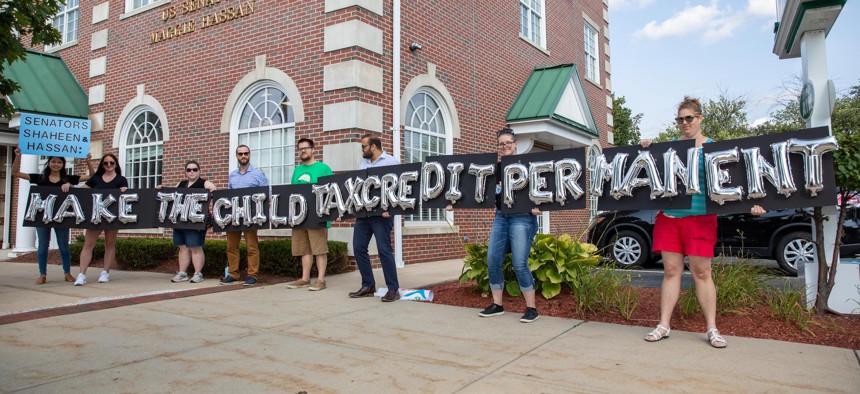State child tax credits can reduce poverty, but only if families apply

New Hampshire parents and other supporters gather outside of U.S. Senator Maggie Hassan's Manchester office to thank her for the enhanced federal child tax credit to be made permanent. While efforts have stalled at the federal level, states are creating their own versions of the credit. Scott Eisen/Getty Images for ParentsTogether
Since the federal child tax credit expired at the end of 2021, 11 states have enacted their own fully refundable versions. But for them to be as successful as the federal credit, states have to get the word out.
Earlier this month, Maine became the 10th state to enact a fully refundable child tax credit. Similar legislation in Oregon is awaiting Gov. Tina Kotek’s signature. And Minnesota approved a massive initiative in May that Gov. Tim Walz described as “not just a nation-leading, but a global-leading child tax credit that will reduce childhood poverty faster than anyplace else.”
Since the expiration of the federal child tax credit at the end of 2021, states have been scrambling to replace it. But in order for these state versions to be as powerful an antipoverty tool as the federal tax credit was, states need to ensure eligible families are taking advantage, one expert says.
In total, 11 states have passed fully refundable child tax credits since 2021, according to a recent report from the Jain Family Institute, a research organization that studies social issues. The way a refundable tax credit works is that when a household is eligible for one and it amounts to more than the taxes they owe, that household receives the difference in cash payments.
The state credits are modeled after the federal expanded tax credit, which gave families $3,600 for children under 6 years old and $3,000 for kids ages 6 to 17. The initiative has been widely credited with reducing child poverty, which dropped to a record low during the pandemic.
Unlike the federal tax credit, though, state benefits vary in scope. Minnesota’s child tax credit, for example, is the largest in the country. It offers $1,750 per child under 17 to families making up to $35,000 annually. Lawmakers are hoping the credit will help reduce child poverty in the state by a third.
In Massachusetts, the tax credit provides $180 per child for all families, regardless of income, but caps at two the number of children eligible for the credit.
In some states, like New York and Oregon, eligibility varies. In those states, the credit cannot go to people who do not have Social Security numbers or individual taxpayer identification numbers, making it difficult for undocumented immigrants to collect a refund. In states like California, Colorado and New Jersey, the credits only apply to children under 6.
But no matter what the child tax credit looks like, its benefits will be moot if eligible families don’t enroll—and there are many barriers preventing such families from doing so, said Jack Landry, a research associate for the Jain Family Institute and author of the report.
Since states have only just started implementing fully refundable child tax credits, one of the most pressing issues is informing eligible families that the credit can benefit them.
“Without any kind of effort to inform families about [the tax credits], I think the vast majority of them will be missed,” said Landry, adding: “If you didn't get work during the year there's no benefits of filing a tax return—until these new credits.”
For many people, filing taxes is a confusing process, especially for those who can’t afford to pay for professional filing services. States could replicate a federal initiative that provides an online portal to make filing easier for low-income families and allow them to apply for the credit without an arduous income-verification process.
The best way to identify and inform eligible families is by using data from existing benefit programs like Medicaid and the Supplemental Nutrition Assistance Program, the report said.
More ambitiously, that data can also be used to facilitate automatic payments, the report noted, a move that would remove the burden of families signing up themselves. But there would be several administrative hurdles states would need to overcome, like determining the best way to deliver the benefits.
Besides the 11 states highlighted in the report, others have nonrefundable child tax credits, which only reduce the amount in taxes a family owes. In other words, they benefit those with incomes high enough to have a tax liability and not households with little to no income, the main target of these credits.
here’s reason to believe lawmakers will continue to tinker with the benefits in the coming years, according to Landry.
"Even though a lot of these state CTCs [child tax credits] are starting with small amounts and can be age restricted … we're really seeing that once a state establishes a CTC, it has a tendency to get expanded," he said.
So far, six states have done exactly that by increasing payments and broadening eligibility.
There is also reason to believe that more states will adopt a credit. While all the states with fully refundable credits are Democratic leaning, the benefits have seen significant support from Republicans. The report found that 40% of GOP state senators and 30% of representatives voted in favor of fully refundable child tax credits, despite opposition voiced by nearly all GOP members in Congress when the enhanced federal credit passed in 2021.
While states continue to develop their own child tax credits, the federal government has explored bringing back the pandemic-era credit. Earlier this year, President Joe Biden called for reinstating the 2021 expanded child tax credit.






